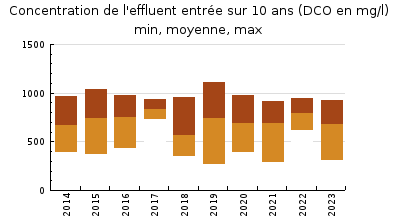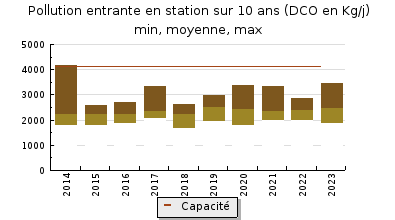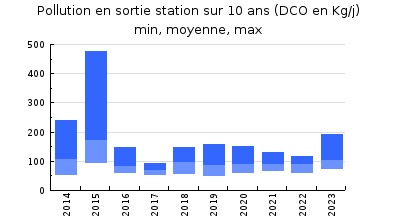Fiche système d'assainissement 2023
TARNOS
Réseau de type Séparatif
| Code de la STEP : | 0540312V001 |
|---|---|
| Nom du maître d'ouvrage de la STEP : | SYNDICAT MIXTE DEPARTEMENTAL D'EQUIPEMENT DES COMMUNES DES LANDES |
| Nom de l'exploitant de la STEP : | - |
| Date de mise en service : | 01 novembre 1971 |
| Date de mise hors service : | 10 octobre 2007 |
| Niveau de traitement : | Secondaire bio (Ntk) |
| Capacité : | 21 800 éq-hab. |
Raccordements communaux 10%..100% 10%..100% |

|

STEP
| Charge nominale DBO5 : | 1 500 Kg/j |
|---|---|
| Charge nominale DCO : | 3 000 Kg/j |
| Charge nominale MES : | 1 526 Kg/j |
| Débit nominal temps sec : | 4 360 m3/j |
| Débit nominal temps pluie : | - |
| Filières EAU : |
File 1 : Prétraitements, Boues activées faible charge, aération p |
| Filières BOUE : |
File 1 : Lits de séchage, Filtration à bande, Stabilisation aérobie |
| Filières ODEUR : | - |
Point de rejet
| Coordonnées (Lambert 93) : | 338 060, 6 281 503 , Coordonnées établies (précision du décamètre) |
|---|---|
| Milieu récepteur : | Rivière- |
Chronologie des raccordements au réseau
 Déployer
Déployer
Observations SDDE 2023
| Système de collecte : Pas d'observation | |
| Station d'épuration : Pas d'observation | |
| Sous produits : Pas d'observation |
Données chiffrées
Attention, cette STEP a été mise hors service le 10 octobre 2007Les données présentées ci-dessous peuvent provenir des différentes STEP suivantes, liées au même système de collecte : 0540312V002 - TARNOS (NLLE COMMUNALE)
Tableau de synthèse
Année d'activité 2023 - Possibilité de déversement par temps de pluie
| Paramètres | Pollution entrante | Rendement | Pollution sortante | |||
|---|---|---|---|---|---|---|
| Charge | % Capacité | Concentration | Charge | Concentration | ||
| VOL | 3 960 m3/j | 62 % | 4 165 m3/j | |||
| DBO5 | 963 Kg/j | 47 % | 272 mg/l | 99 % | 14 Kg/j | 3,4 mg/l |
| DCO | 2 477 Kg/j | 60 % | 686 mg/l | 96 % | 107 Kg/j | 26 mg/l |
| MES | 1 152 Kg/j | 320 mg/l | 98 % | 24 Kg/j | 5,7 mg/l | |
| NGL | 273 Kg/j | 77 mg/l | 90 % | 27 Kg/j | 6,6 mg/l | |
| NTK | 262 Kg/j | 74 mg/l | 92 % | 20 Kg/j | 5,2 mg/l | |
| PT | 31 Kg/j | 8,8 mg/l | 73 % | 8,3 Kg/j | 2,2 mg/l | |
Indice de confiance
| 2014 | 2015 | 2016 | 2017 | 2018 | 2019 | 2020 | 2021 | 2022 | 2023 | ||
| 4/5 | 4/5 | 4/5 | 4/5 | 4/5 | 4/5 | 4/5 | 4/5 | 4/5 | 4/5 |
Pollution traitée






Pollution éliminée


Pollution rejetée




Production et destination des boues

Problèmes rencontrés en 2023
Aucun problème n'a été recensé en 2023
Accès aux données
Pour le système d'assainissement "TARNOS" :
Pour l'ensemble des systèmes d'assainissement du bassin, les données historiques sont disponibles en téléchargement depuis la thématique "Usages et pressions polluantes domestiques et urbaines" ou sous forme d'archive depuis le catalogue de données.
Autre source d'informations : la fiche du Portail d'information sur l'assainissement collectif

 Contact
Contact





 |
|